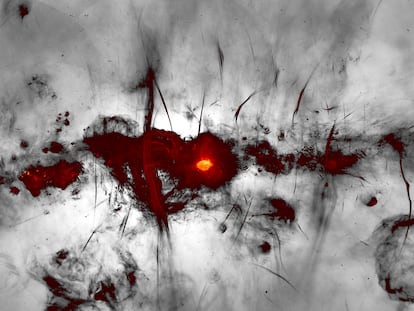How are stars destroyed?
Stars are born. Then, they live and die. And, for them, death is usually quite a dramatic process of complete destruction. Why is this the case?

This article is about astrophysics, thus we refer to the destruction of celestial objects (the Sun among them) that provide us with the energy that’s vital for life.
But curiously, the answer to the question we ask today is not very different from what we could reply about the (self-)destruction of movie stars, about whom we hear more stories than the actual stars. Stars are destroyed by the consumption, even abuse, of substances that cause irremediable imbalances. They are also destroyed by bad company. Pick any movie or music star that you are thinking about when I mention these forms of destruction: I will give you cosmic examples in return.
A professor once taught me that the stars make up the battlefield of two great enemies: pressure and gravity. Each one looks for allies. And, it’s often the case that, in the end, there’s a clear winner.
While comparisons are always odious, they often help to understand the problem. Imagine a balloon. The walls of the balloon, with their latex, prevent air from entering. You have to blow hard so that the pressure of the new air overcomes the balloon’s resistance to deformation and inflates. If we leave the balloon loose and unpinched, the air pressure inside tries to equal what’s outside, causing it to deflate.
We can compare a balloon to a star. The analog to the latex walls compressing the balloon is gravity, which tends to cause matter to become concentrated. As the volume decreases, the density increases. In a star, that matter is gas, mainly hydrogen. When a gas is compressed, its temperature and pressure increase. Just like the air that we introduce into the balloon, the gas of a star — with its pressure — tends to expand the star. There, we have the two contenders: gravity tends to make everything fall towards the center of the star, while pressure tends to make the gas disperse. And, in this great battle, the star spends its entire life — including the stage before its birth — in a gradual process of death and destruction. Everything depends on whether pressure can counteract gravity.
Before a star is born, gravity wins. It’s stronger than the pressure of the gas, because the gas clouds that give rise to stars begin their evolution with temperatures as low as -418 degrees (compared with the Sun’s temperature of about 10,000 Fahrenheit). But the clouds are compressing and warming. The temperature and pressure increases and this could counteract gravity. However, gravity seeks an ally: light! The hot gas emits light, while that energy — carried away by the emission — cools the gas. Subsequently, the collapse continues.
There may come a time when pressure finds its own ally. Depending on the size of a cloud, temperatures can become so high in the center during collapse that they cause hydrogen atoms to collide with each other. By understanding that temperature is the physical property that tells us how fast the gas particles move, it becomes clear that the hydrogen atoms (in fact, they are just protons) end up overcoming their electrical repulsion, fusing to form the nuclei of heavier elements. A star has been born, with a core that hosts nuclear fusions.
First of all, helium is formed (although not directly). Nuclear fusion produces energy and, thanks to that extra energy that the star’s gas receives, the pressure of the gas finally balances out with gravity. Hence, the star becomes stable. Gravity plus light end up pitted against pressure and fusion. But not forever: the contenders get tired. In any case, the Sun has been in this balance for 4.5 billion years. We’re still far away from its destruction.
The destruction of a star comes from the consumption of substances (as was noted at the start of this article). When the hydrogen in the center of the star runs out, or when one of the allies fails, gravity does its thing again and the star is destabilized. This will eventually cause its destruction… but not before going through stages where other elements are produced through fusion. There will come a time when there will be no material to create as much energy required to stop the collapse. And — since it’s impossible to stop the collapse — much more dramatic things occur.
In very massive stars — 10, or even 100 times bigger than the Sun — the amount of material is so large and the collapse due to gravity occurs with such intensity that their cores reach very high temperatures. Fusion then takes place. It’s produced at a much faster rate than in the Sun. These stars live fast and leave a beautiful corpse.
The abuse of hydrogen consumption
The huge amount of energy that massive stars produce raises the temperature of their surfaces to levels at which the simple light they emit carries its own pressure. In other words, light exerts pressure on matter, it pushes gas out, just like a gas would. That pressure is called radiation pressure — it’s high enough in massive stars that it pushes away the outer layers and destroys much of the star, which gradually dissolves. This is the case of the so-called Wolf-Rayet stars, whose images are spectacular. An example is the so-called γ Velorum (Gamma Velorum, the third-brightest star in the Vela constellation), which is actually a group of four companions: one of them is a Wolf-Rayet that has already lost 75% of its mass in about five million years. The fate of these stars is an even more violent destruction, as the abuse of a substances (hydrogen, and then other elements) leads to their total collapse, resulting in a supernova.
We’re missing one more form of destruction: bad company. There are stars who don’t live with the right people. And, funnily enough, those who seem to be the most dangerous aren’t always the ones who manage to destroy their partners. In the celestial context, we can look at two examples of this.
A little over a year ago, an object was detected that had changed its brightness abruptly. Subsequent observations via X-rays, radio waves and an optical spectrum revealed what appeared to be a black hole that had swallowed a star. It first began the process of consumption by deforming it and then tearing it apart, finally expelling part of the cosmic feast in the form of powerful jets of matter, accelerated to almost the speed of light. A spectacular death for hanging out with the wrong person.
The final example is less expected: a normal star, destroyed for being too kind. A star can be wiped out for giving part of its material to a small companion — such as a white dwarf or neutron star — in such a way that the small companion becomes so destabilized that it explodes as a supernova, taking its generous partner with it.
Sign up for our weekly newsletter to get more English-language news coverage from EL PAÍS USA Edition
Tu suscripción se está usando en otro dispositivo
¿Quieres añadir otro usuario a tu suscripción?
Si continúas leyendo en este dispositivo, no se podrá leer en el otro.
FlechaTu suscripción se está usando en otro dispositivo y solo puedes acceder a EL PAÍS desde un dispositivo a la vez.
Si quieres compartir tu cuenta, cambia tu suscripción a la modalidad Premium, así podrás añadir otro usuario. Cada uno accederá con su propia cuenta de email, lo que os permitirá personalizar vuestra experiencia en EL PAÍS.
¿Tienes una suscripción de empresa? Accede aquí para contratar más cuentas.
En el caso de no saber quién está usando tu cuenta, te recomendamos cambiar tu contraseña aquí.
Si decides continuar compartiendo tu cuenta, este mensaje se mostrará en tu dispositivo y en el de la otra persona que está usando tu cuenta de forma indefinida, afectando a tu experiencia de lectura. Puedes consultar aquí los términos y condiciones de la suscripción digital.











































